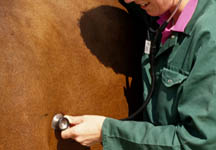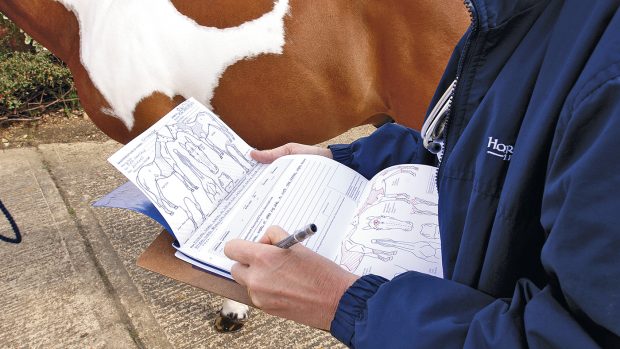More articles on having horses gelded
Find an equine vet
Castration is a routine operation, but should not be taken for granted. As equine vet Richard Payne explains, every case is individual — and while most operations go smoothly, there can occasionally be potentially serious and expensive complications
“Castration, or gelding, is usually done for management reasons and can be carried out more or less at any age,” explains Richard, of Rossdale and Partners, Newmarket.
“Racehorses are usually castrated at the end of their two-year-old season. In other disciplines, breeders like to geld colts before weaning, because they feel it is less stressful.
“There are also occasions when mature stallions are castrated: with the older, fully developed horse there is a potentially greater risk of complication, such as herniation of the intestine.”
Local or general anaesthetic?
The horse’s age, size and previous handling may influence the vet’s decision about where and how to carry out the procedure, either standing under local anaesthetic and sedation, or under general anaesthetic.
There are pros and cons to be considered with each scenario, as Richard explains: “Under the standing category of surgery, it should be done as an open castration, where you open the site, remove the testicles and leave the wound to drain.
“This is a clean but not sterile operation: you try to make it as near sterile as possible, but you’re not in an aseptically prepared operating theatre. I feel that in standing surgery the wound should be left open, without tying anything off or putting in ligatures, because if there is any infection, it drains.
“There is a risk that if you put in a stitch or two, you can think you’ve done a really good job in keeping everything clean — but if infection creeps in, sutures can act as a focus for infection because bugs love ‘foreign bodies’. The worst scenario is that you end up with an abscess.”
In a perfect world, standing castration is performed in a clean environment such as a veterinary hospital, but Richard acknowledges that not all owners have easy access to these facilities. However, this procedure does demand that the horse has a reasonable temperament and has been handled correctly.
Tim Mair, a vet at a Kent equine hospital, says: “It’s usually impossible to castrate a foal when it’s standing, and small ponies are difficult and potentially dangerous to castrate standing. Also, certain breeds such as Shires and Standardbreds may be at an increased risk of evisceration (prolapse of intestine through the surgical wound) following the procedure, and this may affect how it is performed.”
The advantage of castration under a general anaesthetic is that surgery can be carried out in a sterile environment and the wound can be closed — but the risk of death under a general anaesthetic is currently estimated at about one in 100, for all types of surgery.
If either one or both of a colt’s testicles have not “dropped” then standing castration will not be an option. The testicles will have to located before they can be removed, which might involve keyhole surgery.
Aftercare
Correct aftercare means recovery from castration is usually quick; a racehorse can be back in canter work in seven to 14 days.
“After surgery, horses usually need some degree of controlled exercise, such as going on a horse-walker or walking in-hand for half an hour twice a day,” says Richard. “Strict rest is not a good option because it doesn’t reduce the swelling.
“With open castration, you need to wash the blood off the legs, but not interfere with the surgical site or you may let in infection. If horses are gelded in the paddock, you need to keep a close eye on them for the first 48hr. Muddy fields and dirty stables are not a suitable environment for newly castrated horses.
“I usually give five days of antibiotics, plus anti-inflammatories and analgesics as standard. To withhold pain-killing drugs is old-fashioned and inhumane.”
Potential problems
Routine castration is usually straightforward. But there can be complications, ranging from mild infection to serious risks such as evisceration, or peritonitis, an infection of the abdominal cavity.
“A lot of people worry about the risk of haemorrhage, but if surgery is done correctly it isn’t usually a major problem,” says Richard. “The occasional horse will bleed more than average and this should never be ignored, but it isn’t common.”
Schirrous cord is another rare but recognised problem. This is caused by infection in the stump of tissue left behind, which can result in the formation of a closed abscess.
“Over the first three to six months after castration, the horse will develop painful swellings in the groin,” explains Richard. “These may burst out, making you suspect that things have got better, but then you get a cycle of bursting and healing.”
This veterinary feature was first published in Horse & Hound (19 May, 2005)
Looking for more articles on having horses gelded?
Find an equine vet near you


